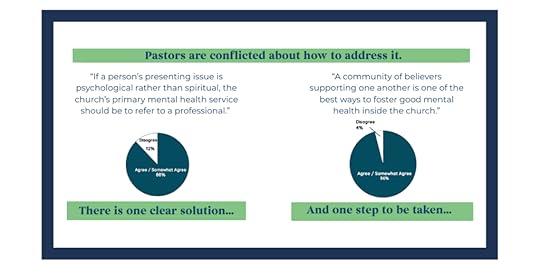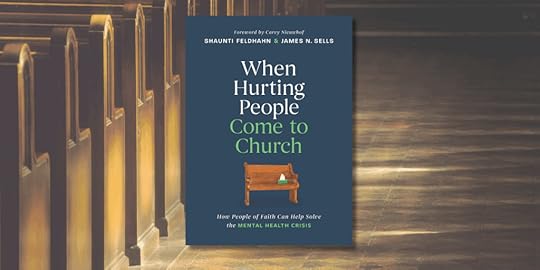What To do ‘When Hurting People Come to Church’
Have you ever had to turn someone away? Maybe you’re an event planner with a wait list to a sold-out event. It could be that you’re a service manager, and you have to tell a customer it will be a week or more before a technician can fix their broken HVAC unit or their dryer or their car.
Now imagine the broken thing you’re waitlisting is a heart.
That’s what a lot of counselors and pastors feel like today, in the middle of what the World Health Organization calls “a global crisis for mental health.” There is so much need that the “professionals” can’t meet it all. This has implications for every one of us—especially those who want to see the church be a place of answers and hope for our culture.
I was talking with a clinical psychologist friend who runs a large counseling center in the Midwest. Her practice is the “go-to” practice for multiple churches. She said the needs are so great that all her counselors are fully booked and she regularly has to do something she dreads: tell a person in pain that they can’t serve them right now. They give the person a list of other practices to try . . . and frequently get a return call saying that none of those clinicians have room right now either. This is a regular, heartbreaking experience.
And this doesn’t even take into account the millions who don’t pursue help at all, because they simply can’t afford professional care.
As just one data point example, among those with severe anxiety alone, 25 million people are not receiving any care. That is more than the population of Florida.
You may be personally aware of this need. After all, every one of us either knows someone with severe anxiety, depression, or other concerns. You may also feel helpless to do anything about the problem. But it turns out: If you care about this issue, you’re a key solution to the problem.
Today I’m launching When Hurting People Come to Church, my latest book, co-authored with clinical psychologist and Regent University leader Dr. James Sells, to propose that the church can help solve this mental health crisis. The book is based on two years of research with more than two thousand pastors and church leaders, including many who are already doing mental health ministry well and have immense wisdom to share.
I’m going to unpack what we are proposing, and I hope you will buy the book and pass it along to every pastor, church staff, and caring church volunteer that you know.
A Fresh Way of Approaching Mental HealthWhen Hurting People Come to Church: How People of Faith Can Help Solve the Mental Health Crisis offers a fresh way of thinking about how the church can help the hurting. It unleashes the church’s greatest resource—its people—to help solve the mental health crisis. Think about it: there are millions of Christian lay people who understand brokenness, grace, and the power of relationship. Many Christians would want to step intocaring for those dealing with basic anxiety, depression, grief, marriage distress, and dozens of other issues if they knew that was an option.
In recent decades, we have thought of “mental health care” as something offered by a clinical specialist—usually, a professional operating outside of the church’s walls. As non-specialists we have begun to feel like we “aren’t allowed” to offer help or care, and that we should always let “the professionals” handle it. And just to be clear, we aren’t suggesting that clinicians aren’t needed! Highly trained and licensed counselors are vitally important. After all, my coauthor is a licensed psychologist who has spent more than thirty years training clinicians to serve the world.
But what if we began to think of the church as the nexus of a “both-and” strategy? Both a place that refers to clinicians when needed and a place where people can find real help and hope for their life pain. I think Jesus would like this idea. After all, in describing Himself and those He came to serve, He said it was not the healthy who needed a doctor, but the sick.
When a young woman shows up at church with severe anxiety or depression, an old man is in grief after losing his wife of fifty years, or a couple tells their home group leader that they are considering divorce, the church can be prepared to bring together the power of God with the power of people to give real care for these real mental and emotional health issues.
What do church leaders think?Based on national research with more than two thousand church leaders, two staggering statistics paint a picture of how conflicted pastors are—and the wonderful opportunity before us.
On our national survey, 88% of pastors and church leaders either agree or somewhat agree with this statement: “If a person’s presenting issue is psychological rather than spiritual, the church’s primary mental health service should be to refer to a professional.”
Yet 96% of those same pastors and church leaders also agree or somewhat agree with this statement: “A community of believers supporting one another is one of the best ways to foster good mental health inside the church.”

So we are in a moment when most pastors and church leaders feel like what they should do for mental health is refer to a specialist (and remember, many specialists are too expensive or full!) yet they also know that having caring people who walk alongside the hurting is one of the best ways for promoting better mental health in the church!
One of the church’s finest moments might exist in the gap between these two numbers. Rather than funneling people away from the church, we have an opportunity before us to train lay people to walk alongside those in distress with listening, caring presence.
Now, an important call to actionThis is where you come in.
When Hurting People Come to Church outlines not just a new movement, but also a new model for helping the hurting. And I chuckle as I write that, because this “new model” is actually as old as the book of Acts. It’s people. It’s community. It’s listening, supportive laypeople—perhaps with a little bit of extra training in listening—who can apply both compassion and wisdom in caring for others.
In recent decades, church leaders have (perhaps understandably) been told, “when in doubt, refer out.” And again, referring to specialists can be incredibly important. But do we really want to create a funnel out of the church? How about, when referrals are needed, referring people to a specialist . . . and ensuring that we walk alongside them in the church at the same time? How about also thinking of “referrals” for the whole scope of human care—where someone in pain is connected to a small group just as purposefully as to a licensed counselor? Or where a marriage in crisis is connected to a couple with a healthy marriage, who they can hang out with and learn from—even if they also go to a marriage therapist for skill building in communication?
As my co-author Jim Sells told me recently, “I can help a client with skill building and symptom reduction. But if they don’t also get connected to people who can walk alongside them, those symptoms won’t stay reduced for very long.”
The church has traditionally been the place where we walk alongside those in need. It’s time for the church to see the mental health crisis not as something separate from the mission of the church, but as a key opportunity for outreach, discipleship and love in the name of Jesus to those looking for hope.
What does “walking alongside” look like?The practical way to meet the needs of this moment is through a structure that fits within the context of your church and mobilizes a team of lay listeners with very basic training, under the leadership of a care coordinator. Explaining this and how it works is the main point of the book, along with a companion initiative, The Church Cares that exists to equip the church.
This approach takes some of the crushing burden of pastoral care from your pastor’s shoulders and raises up a team of trained volunteers who help the lonely feel connected and help the heartbroken find hope. Of course, these lay listeners also learn to identify those who may need more specialized care—but even as a referral is made, the hope is that the person also continues to receive care in the church community.
The church and the counseling office do not have to be mutually exclusive. We need both. As the church, we can—and should—come alongside people in their pain. This isn’t a nice idea. It’s a critical solution for the loneliness, distress, and emotional burdens that are overwhelming our pastors’ offices and our clinical healthcare system.
This book is for those who care about the hurting and find the scope overwhelming.
This book is for anyone with a caring heart who wants to help provide hope.
This book is for you.
Order your copy today. Order a copy for your care pastor, your senior pastor, and for other like-minded, caring friends. And church-by-church, city-by-city, and state-by-state, let’s start a movement that can become the church’s finest moment[LD2] .
If you are interested in having Shaunti bring research-based strategies, practical wisdom and biblical principles to your next event, please contact Nicole Owens at nowens@shaunti.com.
On our podcast, I Wish You Could Hear This, Jeff and I offer proven steps to help you thrive in your life, faith and relationships. In other words, we’ll offer the practical help you’ve grown accustomed to right here in this blog space. You’ll take away specific steps that help you today. Listen, follow, and share with your friends on YouTube, Apple Podcasts, Spotify and other platforms.
Please note: This post may contain affiliate links. As an Amazon Associate we earn a small amount from qualifying purchases through these affiliate links. This doesn’t cost you anything, and helps us continue bringing you great content!
#mc_embed_signup{background:#fff; clear:left; font:14px Helvetica,Arial,sans-serif; } /* Add your own Mailchimp form style overrides in your site stylesheet or in this style block. We recommend moving this block and the preceding CSS link to the HEAD of your HTML file. */ .button {background-color: #3389C2;background:#3389C2;color: #fff} Receive Shaunti’s Blog & Updates* indicates required Email Address * (function($) {window.fnames = new Array(); window.ftypes = new Array();fnames[0]='EMAIL';ftypes[0]='email';fnames[1]='FNAME';ftypes[1]='text';fnames[2]='LNAME';ftypes[2]='text';fnames[3]='SOURCE';ftypes[3]='text';fnames[4]='MMERGE4';ftypes[4]='text';fnames[5]='MMERGE5';ftypes[5]='date';fnames[6]='MMERGE6';ftypes[6]='text';fnames[7]='MMERGE7';ftypes[7]='text';fnames[8]='MMERGE8';ftypes[8]='text';fnames[9]='MMERGE9';ftypes[9]='text';fnames[10]='MMERGE10';ftypes[10]='phone';}(jQuery));var $mcj = jQuery.noConflict(true);More from Shaunti’s Blog: What To do ‘When Hurting People Come to Church’Have you ever had to turn someone away? Maybe you’re an event planner with a wait list to a sold-out…
What To do ‘When Hurting People Come to Church’Have you ever had to turn someone away? Maybe you’re an event planner with a wait list to a sold-out…
 Try the ‘Next-Day Rule’ Hack for a Happier MarriageDo you want a simple hack that can help your husband be delightfully engaged—rather than accidentally prompting him to withdraw?…
Try the ‘Next-Day Rule’ Hack for a Happier MarriageDo you want a simple hack that can help your husband be delightfully engaged—rather than accidentally prompting him to withdraw?…
 6 Ways to Talk about Gender Differences (Part 2)I think we can probably all agree that we are living in a weird moment. Ten years ago, who would…
6 Ways to Talk about Gender Differences (Part 2)I think we can probably all agree that we are living in a weird moment. Ten years ago, who would…
 6 Ways to Talk about Gender Differences (Part 1)It seems like everywhere I turn lately—while being interviewed on a podcast, speaking at a church, or even talking to…
6 Ways to Talk about Gender Differences (Part 1)It seems like everywhere I turn lately—while being interviewed on a podcast, speaking at a church, or even talking to…
 Our Daughter Said Yes!!!We knew this day would come. That little peanut who was born 25 years ago, who we have adored and…
Our Daughter Said Yes!!!We knew this day would come. That little peanut who was born 25 years ago, who we have adored and…
 What Your Husband Is Really Thinking When He Wants Sex You’re all for intimacy and connection. But your husband is making moves, and you are tired. You can’t help but…
What Your Husband Is Really Thinking When He Wants Sex You’re all for intimacy and connection. But your husband is making moves, and you are tired. You can’t help but…The post What To do ‘When Hurting People Come to Church’ appeared first on Shaunti Feldhahn.



